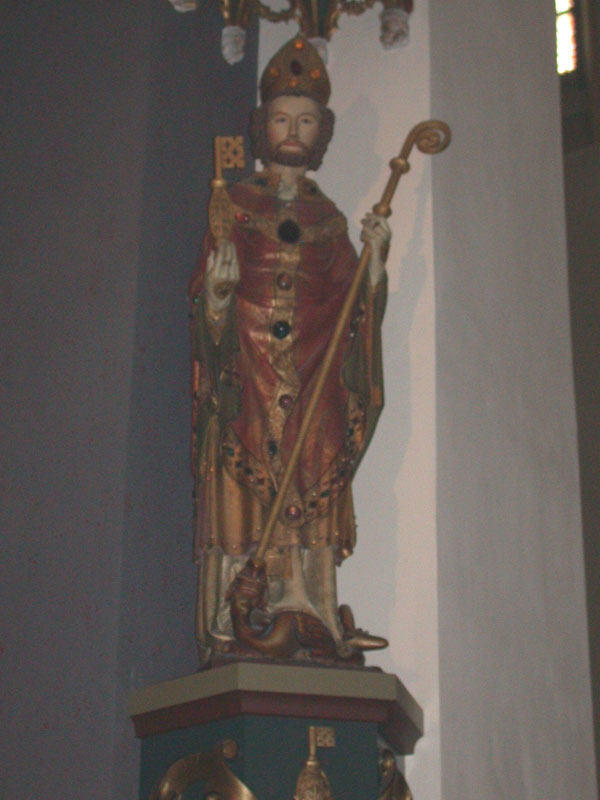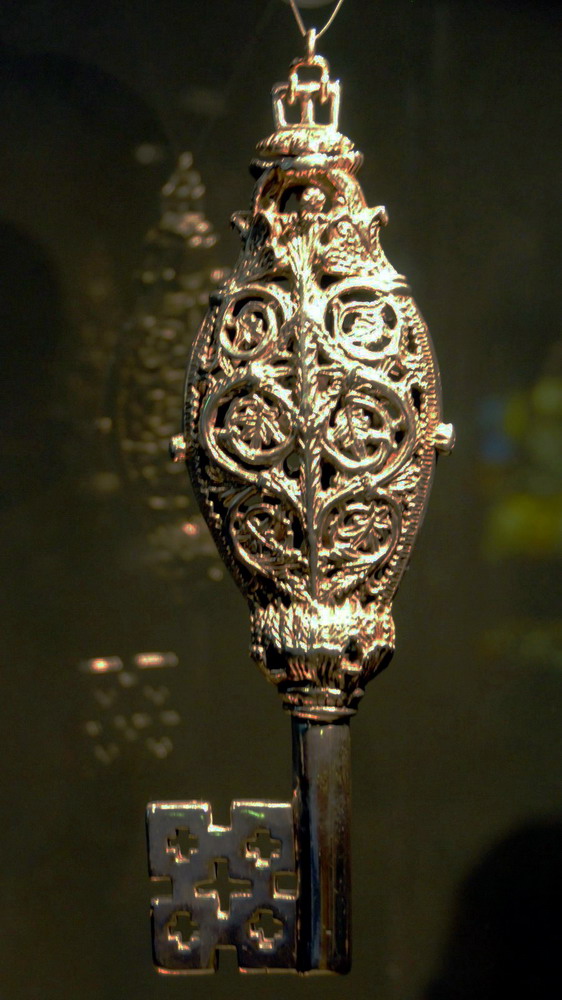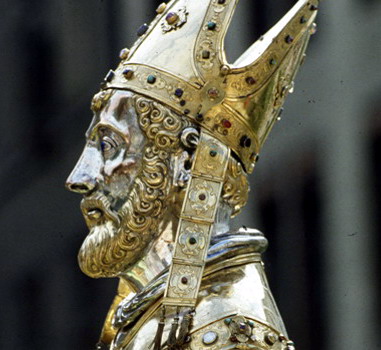Détail du buste- portrait contenant le crâne
deSaint Servatius, trésor de la Basilique de Saint Servatius,
Maastricht, Don d’Alessandro
Farnese, Duc de Parma.
Saint Servais
Évêque de
Tongres (✝ 384)
Évêque de Tongres
et de Maestricht, il lutta aux côtés de saint Athanase
d'Alexandrie, exilé à Trèves, pour défendre la pureté de la foi en
la divinité du Verbe de Dieu, face à l'hérésie arienne.
Voir aussi traditions, ville de Gimné, vie de saint Servais.
À Maästricht
sur la Meuse, vers 384, la naissance au ciel de saint Servais, évêque de
Tongres, qui se battit pour la foi orthodoxe de Nicée dans plusieurs conciles
où l’on disputait de la nature du Christ.
Martyrologe
romain
Évêque de Tongres, saint Servais, patron de la
paroisse et de l'église de Gimnée, est un des grands personnages de la
chrétienté. La discrétion de l'histoire de sa vie est quelque peu compensée par
la légende qui ferait de lui un cousin du Christ et descendant d'une soeur de
sainte Anne. Son nom trahit une origine orientale, peut-être arménienne. Il
aurait été ordonné prêtre à Jérusalem et envoyé à Tongres par un ange. Attila
aurait épargné le saint à la vue d'un ange qui le protégeait. A Rome, il aurait
également reçu une clef d'argent des mains de saint Pierre...
Saint Servais prit probablement part au concile de Sardique en 343, parmi les
évêques qui soutiennent Athanase et défendent l'orthodoxie. Lors du concile de
Rimini en 359, il défendit avec énergie la foi catholique devant l'arianisme
qui refusait le dogme de la Trinité. Les défenseurs de l'orthodoxie étaient peu
nombreux, mais, comme le raconte Sulpice Sévère, "plus réduit était leur
nombre et plus grand était leur courage". Phebadius, évêque d'Agen, et
Servatio (saint Servais), évêque de Tongres, étaient les plus tenaces.
Phebadius finit par céder, Servais restant seul, indépendant et obstiné.
Finalement, Servais, droit, simple et ferme, se laissa manoeuvrer et finit par
signer un compromis retors dans lequel les Grecs rusés lui proposaient des
formules subtiles où l'hérésie se cachait sous des mots relevant apparemment de
l'orthodoxie.
Entre le concile de Sardique et celui de Rimini, vers 350 ou 351, saint Servais
a probablement été envoyé comme ambassadeur de l'usurpateur Magnence à
l'empereur Constance.
Ses reliques furent transportées à Maastricht où l'évêque Monulphe lui dédia
une basilique au VIème siècle. Son corps est abrité dans une lourde châsse
romane.
Le nom de saint Servais, évêque très populaire, est un patronyme très répandu:
dix-neuf églises et une ville l'ont reçu comme titulaire. L'église de Gimnée
lui est dédiée ainsi que celles de Dourbes, Olloy, les deux Matagne, Fagnolle,
et enfin Ossogne et Matignolle, situés sur Vierves. Fêté le 13 mai, saint
Servais est le dernier des saints de glace.
Clef de saint
Servais
Partons pour la Belgique en faisant mémoire de saint Servais, grand évêque du IVe
siècle. Il était évêque de Tongres dans le Limbourg belge, alors que la
redoutable hérésie de l'Arianisme déferlait de l'Orient en Occident. Selon
l'hérétique Arius, le Christ n'était qu'une créature, certes d'exception, que
le Père avait adoptée, sans qu'elle soit vraiment Fils de Dieu. L'Arianisme
battait ainsi en brèche la base même de la foi chrétienne : le mystère de
l'Incarnation du Fils de Dieu, vrai Dieu et vrai homme.
Saint Servais fut l'un des premiers en Europe à se
rallier aux professions de foi des Conciles de Nicée en 325 et de
Constantinople en 381, et des illustres évêques d'Orient au IVe siècle,
défenseurs intrépides de la vraie foi : de Basile de Césarée à Athanase
d'Alexandrie. Servais anime les conciles régionaux siégeant à Cologne en
Allemagne et à Rimini en Italie, pendant que les Huns commencent à envahir le
nord de l'Europe. L'évêque Servais sera obligé de quitter Tongres, emmenant ses
fidèles et sa bibliothèque. C'est à Maastricht en Hollande qu'il achève son
parcours terrestre le 13 mai 384. Il fut lui aussi un saint "européen"
!D'origine latine : "servus, servire" : être soumis ,dévoué à.
Rédacteur: Frère Bernard Pineau, OP
Servatus of Tongres B
(RM)
(also known as Servais)
Died in Tongres, Belgium, May 13, 384. Bishop Servatus of Tongres (Belgium)
hosted Saint Athanasius, when the latter was an exile in the West because of
the Arian persecutions. He strenuously defended his friend and the cause of
orthodoxy, especially at the council of Sardica (Sofia). Saint Gregory of Tours
relates that Servatus foretold invasion of Gaul by the Huns and implored the
divine mercy to avert that scourge by watching, fasting, prayers, many tears,
and a pilgrimage to Saint Peter's tomb in Rome in 382. Regardless of his
pleading with the Almighty, God revealed to him that punishment was necessary.
Still weeping, he hastened back to Tongres, where he sickened and died soon
after. Gregory testifies that many miracles occurred at his tomb, which caused
a church to be built over the relics of the man who had governed the diocese
for 37 years. Most of his relics are housed in the collegiate church in
Maestricht. Shortly after his death, the city of Tongres was plundered by
Attila. Some have claimed that Servatus moved his see to Maestricht, but the
translation was made only after the destruction of Tongres (Benedictines,
Husenbeth).
In
art, Saint Servatus is generally a bishop with three wooden shoes. He may
sometimes be portrayed (1) at a reading desk with a shield by him with three
wooden shoes; (2) being met at the city gate by burghers as he holds the key
and is attended by an angel; (3) with a key in one hand, placing his crozier on
a dragon; (4) striking water; or (5) with an eagle fanning him as he sleeps in
the sun dressed as a pilgrim (Roeder). Servatus is invoked against foot
troubles, lameness, rheumatism, rats, and mice (Roeder).
May 13
St.
Servatius, Bishop of Tongres
HE gave St. Athanasius
during his banishment, a friendly and honourable reception, strenuously
defended his cause, and the Catholic faith, especially in the council of
Sardica; resisted the Arians at Rimini, and laboured much in preventing the ill
consequences with which the church was threatened by the misconduct of the
bishops in that council, through the fraud of the Arians. St. Gregory of Tours
relates that he foretold that the Huns would invade Gaul, and implored the
divine mercy to avert that scourge by watching, fasting, prayers, and many
tears, and by a pilgrimage to Rome to the tomb of St. Peter. This penitential
journey he undertook in the year 382, that he might obtain the patronage of the
apostles in behalf of his people, for whom he never ceased to implore the
divine mercy by watching, fasting, and prayer, accompanied with tears. But he
was informed by a revelation that God had determined to punish the sins of that
nation, which calamity, like Ezechias, he was assured his eyes should never
behold. Thereupon, weeping, he hastened back to Tongres, where he shortly after
sickened and died, on the 13th of May, 384, having been bishop about
thirty-seven years, not fifty-six, as is affirmed in the new edition of Moreri.
St. Gregory testifies that miracles drew many to his tomb, and that a church
was erected over it. His body remains in the noble collegiate church in
Maestricht, except some small portions distributed in other places. The city of
Tongres was shortly after plundered, and left in ruins by Attila, since which
time, it retains nothing of its ancient splendour. Some pretend that St.
Servatius removed his episcopal see to Maestricht a little before his death:
but it is certain that translation was only made in the following century,
after the city of Tongres was destroyed by Attila. See the works of St.
Athanasius, St. Gregory of Tours, Hist. Francor. &c. in Henschenius, p.
210. Also Rivet, Hist. Littér. de la France, t. 1, part 2, p. 242. Foullon,
Histor. Leod. t. 1, p. 43, and Henschenius, in the Acta Sanctorum, in his
Exegesis De Episcopatu Tungrensi et Trajectensi, prefixed to t. 7, Maij.
Rev. Alban Butler (1711–73). Volume
V: May. The Lives of the Saints. 1866.
Also
known as
- Servaas
- Servatius
- Servais
Profile
Bishop
of Tongres
(in the modern Belgium)
for 37 years. Welcomed Saint Athanasius
of Alexandria during his exile
by the Arians.
Worked to remove heretical
bishop
of Cologne,
Germany
in 346.
Active at the Council of Rimini in 359.
Prophesied the mid-5th
century invasion of Gaul by
the Huns.
Born
- 13
March 384
at Tongres,
Belgium
of fever
- initially interred
at Tongres
- miracles
reported at his tomb including that snow would not accumulate on it no
matter how deep it was all around it
- relics
translated to the Saint Servaas Basilica,
Maastricht,
province of Limburg, Netherlands
when Tongres
was sacked
- against
foot problems
- against
lameness
- against
leg problems
- against
mice
- against
rats
- against
rheumatism
- for
success
- bishop
holding a key and accompanied by an angel
meeting burghers at a city gate
- bishop
holding a key in one hand while placing his crozier on a dragon
- bishop
reading desk where nearby sits a shield with three wooden shoes
- bishop
with three wooden shoes
- man striking water with a staff
- pilgrim sleeping in the sun while an eagle fans him
- SOURCE : http://catholicsaints.info/saint-servatus-of-tongres/
Statue
de Saint Servatius sur le pont de saint Servatius à Maastricht, œuvre de
Charles Vos, 1934
Servatius was the
first bishop of Tongeren, the capital of the Tungri in the east of what is now
called Belgium. In the fourth century, it belonged to a province of the Roman empire called Germania Secunda. In those days,
Christianity was quickly gaining ground. In 311, the emperor Galerius had put an end to the great
persecutions, and another emperor, Constantine I the Great, actually favored
the Church. For example, he gave juridical powers to the leader of a Christian
community in a town, the bishop. Moreover, he gave fiscal privileges to the
funds of Christian charity, for which the bishop was responsible. From now on,
a wealthy man could show that he cared for his community by becoming bishop,
and many members of the Roman elite converted.
The first known
bishop in the Low Countries is Maternus of Cologne, who attended the Council of Arles in 314. (During this
meeting, the Church gave up its pacifism.) Servatius belonged to the next
generation. According to a medieval legend, he was not born in Tongeren, but in
Armenia. This piece of information is a bit
problematic, because a bishop needed to possess land near the town where he
resided. It was the only way to manage the capital needed for charity. We can
of course assume that Servatius sold all his worldly possessions before
traveling to the far west, where he invested his money in land again, but
this is a bit farfetched. On the other hand, why would a medieval hagiographer
risk his credibility by inventing an Armenian descent?
However this me be, Servatius
must have been a rich man, because he was able to travel throughout the Roman
empire. In 343, he was present at the Council of Serdica (modern Sofia), where
a man named "Sarbatios" signed a decree against the followers of the
theologian Arius of Alexandria, a man of immense learning who
had spoken about Christ in terms that appeared to debase the divine nature of
the Savior.
In this debate, the
western and eastern halves of the empire took different positions. The eastern
emperor Constantius II agreed with Arius that
Christ was neither co-eternal nor of one substance with God the Father, but had
been created as an instrument for the salvation of mankind. Christ was,
therefore, subordinate to the Father, and his nature was not divine but human. The
western emperor Constans, a brother of Constantius, said
that the Son and the Father were of the same substance - in other words, that
Christ was truly God. In this debate, Servatius, who had traveled 3,000
kilometers to be present, represented the views of his emperor. Because the
eastern bishops shared the opinions of their ruler, the Council of Serdica was
a failure.
Seven years later,
the western emperor Constans fell victim to a plot. During a dinner party, a
group of courtiers proclaimed Magnentius emperor, and Constans was
murdered (350). The new emperor sent "Sarbatios" as an envoy to
Constantius. The bishop of Tongeren had to explain that Constans had behaved
like a tyrant and had suppressed the population with high taxes. The aim of
Servatius' mission was, of course, to obtain recognition of his emperor from
the ruler of the east. He met Constantius in Edessa
in Syria (after a trip of 5,000 kilometers), but was unable to appease his
host. The result was an extremely bloody civil war, which lasted two years and
resulted in the death of Magnentius (351-353).
We do not know why Magnentius
sent Servatius as an envoy, but it suggests that the bishop belonged to the
inner circle of the usurper. Since he seems to have had his base of power in
northern Gaul, it is possible that both men were friends.
In 359, the emperor
Constantius, now sole ruler of the Roman empire, decided that the time had come
to end the religious debate on the nature of Christ. A new Council was summoned
at Rimini, where the emperor wanted the bishops to agree on a compromise. However,
the opposition was strong. One of the most eloquent speakers against the
emperor's proposal was Servatius of Tongeren.
This time, our source, Sulpicius
Severus, calls him "Servatius", not "Sarbatios". The
difference between the two versions of the name can be ignored: our sources for
the Council of Serdicca and the failed embassy are written in Greek, and the
Greeks wrote the sound /v/ with a beta.
This is all we know
about Servatius from official, ecclesiastical texts. However, he was also
remembered in his diocese as the builder of two churches: one in Tongeren, and
one in Maastricht. As far as Tongeren is
concerned, the tradition has been confirmed by excavations. Under the medieval
basilica of Our Lady, the remains of a pretty large fourth-century church have
been identified. Excavation of the basilica of Our Lady Star of the Sea in
Maastricht, one of the most beloved sacred places in the Low Countries, has not
been possible, but it is likely that this church was founded by Servatius as
well. It was built on the site of an older, pagan sanctuary and must have been
a small chapel - not to be compared with the church of Tongeren - because
fourth-century Maastricht was a small fortress.
Three years after the Council of Constantinople, where the
teachings of Arian were finally condemned, Servatius probably died in
Maastricht (384). From now on, Maastricht was to be the seat of a bishop. It
was not very usual to transfer the capital of a diocese, and we do not know why
this happened.
An explanation has been offered
by bishop Gregory of Tours, who wrote, two centuries after the death of
Servatius, that a bishop of Tongeren named Aravatius had been ordered by Saint
Peter to leave Tongeren and settle in Maastricht. Tongeren, Peter said, was to
be destroyed by the Huns because of the sins of its inhabitants.note When
Aravatius had arrived at Maastricht, he fell ill of a mild fever, died, and was
buried beside the public highroad. This story has been accepted by several
scholars, who usually interpret the "sins" as a reference to a
quarrel between the shepherd and his Tungrian flock. An additional argument is
that the tomb of Servatius is still venerated on a place that was once near the
road to Tongeren.
However, this theory must be
rejected. In the first place, "Aravatius" is simply not the same name
as "Servatius" or "Sarbatios". In the second place, the
invasion of the Huns took place in 451. Finally, Gregory finishes his story
with the remark that later, the holy body was moved elsewhere. If we want to
accept Gregory's story, we must assume that he made no less than three errors,
and although the saintly bishop of Tours is quite capable of mistakes, this is
a bit too much. The idea that Servatius moved the bishop's seat to Maastricht
after a quarrel is insupportable.
So we are left with a bishop of
Tongeren who played a role of some importance in the Roman empire and built a
church in his hometown. Probably, he also built the chapel of Maastricht. There
is no reason to doubt that he lies buried in the basilica of Saint Servatius at
Maastricht, which was founded in c.560.
The holy day of the first
Christian leader of Belgium and the Netherlands is 13 May. His three basilicas
- Our Lady in Tongeren, Our Lady Star of the Sea in Maastricht, and Saint
Servatius in Maastricht - are among the most beautiful medieval monuments in
the Low Countries.
Voir aussi :Abbé L. CAMPION. S. Servatius, évêque de Tongres,
patron de Saint-Servan - http://www.persee.fr/web/revues/home/prescript/article/abpo_0003-391x_1903_num_19_3_1181







